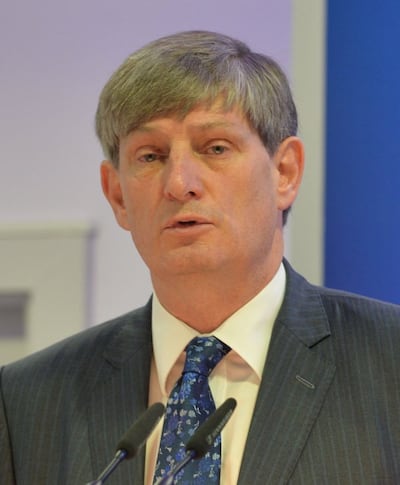Spurred on by the crisis that is being caused by climate change, the world’s global energy market is undergoing unprecedented upheaval. And the pace will only get quicker. Because it must.
Nowhere is that more obvious than with renewable energy, which will change Ireland’s energy supplies dramatically away from fossil fuels to wind, solar and bioenergy by 2030.
The scale of transformation is such that "the next 10 years are going to see change that we probably cannot imagine," says ESB chief executive Pat O'Doherty.
“We need to completely rethink how we use energy and where we get it from, but it is not clear yet what this means in practice. We don’t have the luxury of time to wait around for breakthrough innovation to happen,” he says.
The domination of the market by traditional giant utilities is being disrupted and a “distributed and digital” model will take root, where smart communities and tech-savvy consumers become energy players, not just customers.
Decentralisation will mean locally-based energy networks will become 'the new normal', enabling easy delivery of locally-produced energy to the grid
Climate change commitments and ever more demanding EU targets means that power generation, transport and heat will increasingly have to be produced from sustainably-produced electricity.
Cheaper costs will lead to more sustainable energy use, while bioenergy, especially biomethane, could flow through the existing natural gas network – not just fossil natural gas.
Decentralisation will mean locally-based energy networks will become “the new normal”, enabling easy delivery of locally-produced energy to the grid and flexible energy consumption.
No one predicted the huge drop in wind and solar energy costs over the past decade, says O’Doherty. However, he dismisses notions there will be a seamless transition to a Utopian 100 per cent renewable future.
Climate change commitments
Despite some of the rhetoric to be heard, Ireland is currently struggling to meet existing climate change commitments, minus critical legislation, overdue State supports and incoherent planning rules.
However, a transition to a new energy age is not an impossible ask. Ireland is close to achieving its 2020 targets for renewably-produced electricity generation, if it is behind on longer-term pledges.
Preliminary numbers from the Sustainable Energy Authority of Ireland (SEAI) show that more than 30 per cent of Ireland’s electricity consumption last year came from renewables – more than double the 2010 figure.
Recently, EirGrid announced that two-thirds of the electricity carried at any point on the electricity grid throughout the island of Ireland can come from renewable sources – a world’s first.

However, the latest targets will challenge: emissions from transport, heating and electricity generation must fall from 37 megatonnes of carbon in 2016 to just over six megatonnes in 2050.
Complicating matters, Ireland’s population is expected to rise by 30 per cent during that time – leading to up 500,000 more homes and, potentially, one million more cars. Without major change, more carbon will arise.
Heat pumps and electric vehicles (EVs) offer immediate and longer-term carbon savings, O’Doherty suggests, though “high-efficiency gas” will be required as “a transition fuel”.
If properly adopted, Ireland will have “an early start” to cope with carbon-intensive transport and heating, he says, adding that by 2030 a third of houses will have a heat pump while two-thirds of new cars will be EVs.
The dangers of the "wait-and-see" approach have been highlighted too by Marie Donnelly, former head of the European Commission's Directorate-General for Energy: "We can be part of it, or wait for it to be done to us."
In the new era, four elements will stand out:
Distributed generation – where power from renewable sources, including micro-generation in homes and factories will play an increasingly significant role.
Distributed storage – which will depend on the widespread use of not yet fully-developed batteries to store electricity locally for use during peak periods or as back-up.
Energy efficiency – increasingly available and affordable devices that will help to cut energy demand.
Demand response – technology that will help control energy usage during peak and high pricing periods.
Wind and solar have the potential to deliver the quickest wins. Onshore and offshore wind need the same help from the State, says Irish Wind Energy Association chief executive Dr David Connolly.
Route to market
Both need a guaranteed route to market with appropriate incentives and supports from the State), but they also need clear rules governing their connectivity to the grid and the right planning environment.
In the case of onshore wind, those rules were put in place 10 to 12 years ago, backed by a clear plan. However, the same situation does not apply for those seeking to build offshore wind turbines.
In short, there is too much uncertainty, Connolly tells The Irish Times: "If I was to start an offshore project tomorrow, I don't know how to get planning."
Meanwhile, Ireland has some natural advantages in solar, even if that surprises despite the recent good weather. It gets more sun than Germany, for a start. But there are obstacles, says the Irish Solar Energy Association.
Those in the business of producing solar are frustrated with Government delays in introducing the Renewable Electricity Support Scheme (RESS), says the organisation’s chief executive Michael McCarthy.

Frustration is exacerbated by rules hindering their ability to send their solar-produced energy into the grid, “which is not conducive to a good regulatory environment”.
Private companies began to invest in solar in 2015 on the back of the Goverment’s RESS pledges , but this was subsequently delayed for three years. So far, €20 million has been invested.
With proper help, McCarthy argues that up to €2 billion worth of foreign investment could flow in. If not, the investment will be lost. So, too, will be the chance of 7,000 jobs.
Future demand will be huge. Microsoft wants to build four data centres in Ireland. Apple may yet go ahead with its previously-aborted plan to build one, but not in Athenry. If it does, 3.5GW of electricity will be needed.
“It would take 2 GW of solar projects just to meet the daytime energy requirement of these data centres,” says McCarthy, who highlights the quick wins solar can offer Ireland as it seeks to cut CO2 emissions.
“Solar can deploy 1.5 GW between now and 2020 and thus ameliorate the targets shortfall and save the Exchequer from exposure to EU financial sanctions.”
Everyone has a role to play, says SEAI chief executive Jim Gannon. Greater energy efficiency is a priority. So, too, is the costly retrofitting of buildings: "It will require a mind shift in how we do business and how we live our lives."
We are, as a country, playing catch-up on our obligations
However, people can be “nudged” into better behaviour: “We can bring more people in and then along the journey towards reducing the carbon intensity of Ireland’s economy and society,” he says.
Many unknowns
There are many unknowns on the road ahead, such as the exact contribution that still-developing battery technologies and the capture of carbon dioxide and its subsequent storage will make.
The other big "unknown", however, is Brexit, since it could threaten the all-Ireland Single Electricity Market (I-SEM) – something which is "tangible proof that co-operation works" , says Minister for the Environment Denis Naughten.
However, the relationships built up between EirGrid and its Northern Ireland counterpart, SONI, on one hand, and ESB and NIE Networks, on the other, provides reassurance.
Ultimately, everything will hinge on the final deal, Naughten accepts: “There is no reason to believe that oil, gas and electricity will not continue to be traded post-Brexit.”
In the meantime, links with continental Europe are being deepened. EirGrid is working to build an Celtic Interconnector to France, which will link Ireland to the continental energy market.
Once constructed, it will improve energy security and boost Ireland’s ability to find buyers for hard-to-store renewable energy production and to import such energy in the other direction when needed.
Furthermore, it will create the means by which Ireland could become a net exporter of energy in the decades to come if plans to produce 50GW from offshore and tidal energy by 2050 bear fruit.
Ireland’s final National Energy & Climate Plan to bring about CO2 reductions must go to Brussels by 2019. Difficult days lie ahead, Naughten admits, frankly. “We are, as a country, playing catch-up on our obligations. This is as much our opportunity as our obligation. In any event, it is a moral necessity and a vital national interest,” he says.









